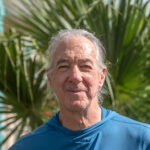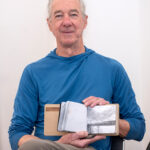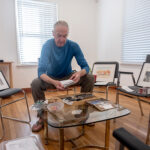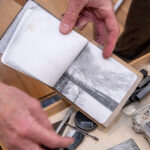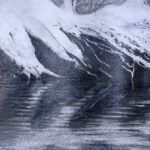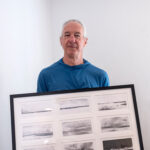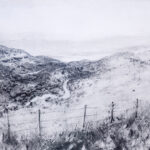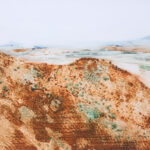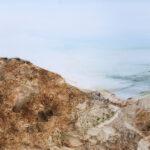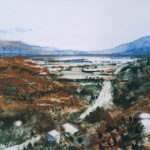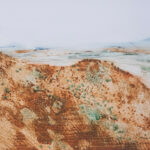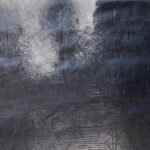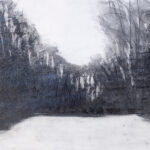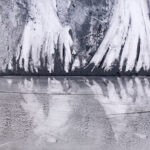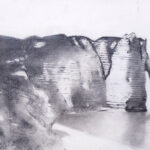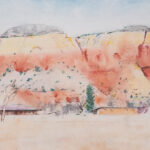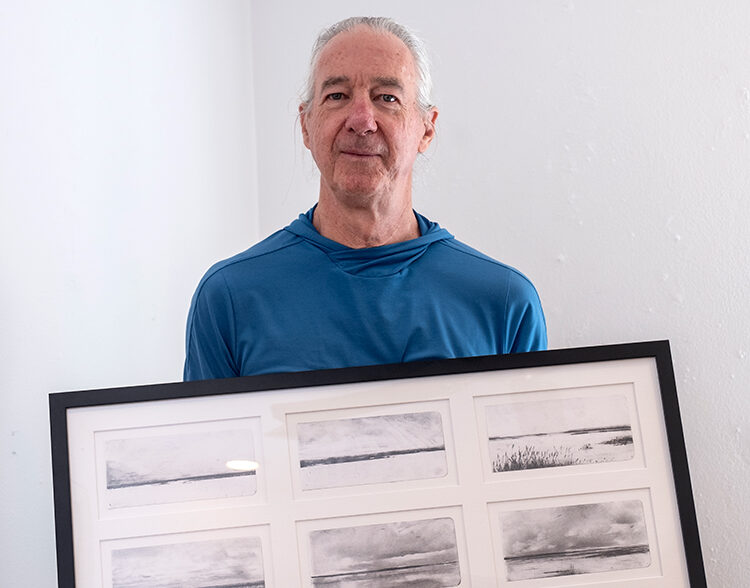
After many years of routinely drawing, Steven Edgar Bradbury appears fused with his chosen art discipline at this stage of his life. His art, primarily graphite drawings on Yupo, a treeless paper from Japan made of polypropylene, has become widely recognized near and far. A solo show of his artwork is on display at the Center for Spiritual Care through Jan. 28.
Bradbury says he finds it exciting to work outdoors, and always carries a writing instrument and a notebook on his walks and excursions.
“Cameras are great, but they cannot capture the wealth of detail that the human eye can. Most of the work I do are 30-to-40-minute drawings I make on my daily walks or plein air excursions. I take walks and see something and start drawing. I draw almost every day, walking three to six miles. Like a musician, you have to do your scales every day. You have to draw every day to keep up with it,” says Bradbury.
“It takes me 15 minutes to an hour to do a sketch. If I kayak on the river, I may do two or three.
A sketch pad itself is such a wonderful thing to hold in our hands. I now have 20 or so sketch pads. I don’t remove a sketch until someone might want to buy it. If I take care of the quantity, God will take care of the quality.”
After growing up in south Florida, Bradbury studied briefly in the 1970s at Cooper Union in New York City. In the ’80s he studied Chinese painting and calligraphy in Taiwan, before beginning a career that included being a literary translator and, for some 20 years, a literature professor.
In 2015 Bradbury decided to pursue art full time so he quit his job and returned to Florida. He settled in Fort White, Fla., home to the Ichetucknee River, which he calls “one of the longest spring-fed rivers in the world and among one of the most beautiful corners of a beautiful state,” and a few years later, he moved to Melrose.
Although Bradbury does occasionally work in other mediums, he gravitated to graphite when he returned to art, relating to its “rich darks and silvery sheers, which remind me of film noir and moonlit nights.”
“I didn’t know how to use color,” says Bradbury, adding while he has drawn in pastels, he didn’t have enough color knowledge to paint with oils.
“All I knew how to do was draw, so I developed some new techniques, and turned my weaknesses into strengths,” says Bradbury. Among them is the use of watercolor graphite, a water-soluble graphite that, when mixed with water, becomes like an ink wash.
Bradbury’s black and white artworks are distinctive, especially when shown with other mediums, standing out in what he calls “the scarcity principle,” explaining that there is not a lot of competition in this unusual medium.
“A lot of people think my graphite drawings are a print or a photo. I seem to have a unique medium and look,” says Bradbury.
He uses Chinese brushes and unusual applicators, such as rolling pins, wet wipes, cotton balls, paint trimming sponges, stones or whatever is at hand, to create texture on the synthetic Yupo paper, which he prefers over standard watercolor paper.
“If you apply something it produces texture. It is difficult to control, but capable of amazing effects. It doesn’t buckle when moistened and has the additional advantage of allowing you to wipe it down and start afresh,” says Bradbury. “On Yupo, it’s more like seizing a happy accident.
A lot is just chance or luck.”
Bradbury says the pencil remains the instrument of choice for most graphite artists. The black core of a typical “lead” pencil is not lead at all, but rather graphite, a form of carbon once so rare that in England, for centuries the only high-quality source, miners were routinely searched to make sure they weren’t smuggling it out.
In addition to the graphite pencil, he says, “there are many types of graphite tools, such as graphite powder, graphite sticks and graphite putty, the last of which I use to make intense darks.”
Bradbury has also used dirty erasers, scissors, a cuticle pusher, ruler, triangle and curved metal to make curved lines, commenting that their use prompted one of his students to say, “It’s all just tricks,” and another to ask, “Why don’t you just use a camera?”
When COVID hit, Bradbury says that in order to stay away from people, he began drawing clouds.
“Clouds were the first thing I fell in love with, after my mom – way before girls. It’s so flat here and the clouds keep changing. You have to be very fast; they move so quickly. They have magnificent forms. It’s such a pleasure to look at them. It was just me in those hay fields; there was no one else around. It was very peaceful and beautiful.”
Since 2017, Bradbury’s works have been on display at numerous solo and group exhibits, in Texas, Illinois, Arizona, Georgia, Colorado, Washington and New Jersey. He earned Best in Show awards twice at the Gainesville Fine Arts Association, First Place at shows in Palatka, Fla., and Springfield, Ind., and received the Art of Distinction Award in Asheville, N.C. Additionally, in 2021, Bradbury won a PEN Award for Poetry in Translation for the book “Raised by Wolves: Poems and Conversations,” by Taiwanese poet-filmmaker Amang.
Photos by Joshua Kodis

